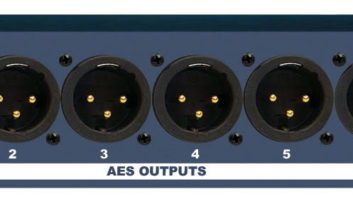(click thumbnail)Fig. 1: Scrutinize used RF connectors before putting them to use.Charles “Buc” Fitch is a registered professional consulting engineer who still gets his hands dirty when he’s not filing applications at the FCC or writing for RW.
Not long ago, he was troubleshooting an older Moseley STL receiver that was DOA. The problem turned out to be a shorted 10V line. Interestingly, the short didn’t blow a fuse or fry any parts. The short was after the current liming resistors, electrically at the top of the zener regulator. The resistors got a little hotter, but that was all.
It seems that the 10-volt distribution wire, a #20 red insulated wire running between sections, had been crimped under the edge of a metal circuit cover. It took a while to find the short, but the fix was simple. Buc redressed the wire so that it wouldn’t be crimped again, then covered the little section of cut insulation with some RTV.
Typically, engineers would use electrical tape. But the drawbacks to tape include trying to get the wire completely covered, and the tape peeling off as the adhesive dries out. RTV, for room temperature vulcanizer, is great for this sort of fix; it goes on topically, like window caulk, yet dries hard and has high-voltage insulation qualities as marked on the tube.
Buc had a similar problem with a cover short on an FM antenna. The antenna left the factory with one of its two deicer wire legs that expected to see 208 volts shorted to the antenna/tower ground. Unfortunately this problem was discovered after the tower crew had left.
For a short period, they had to put electrical neutral on that shorted-to-ground wire, with 120V on the “good” other side until the climbers returned. Thank goodness there wasn’t any severe icing in the interim, as they could only run about half power heat with this arrangement.
Reach Buc at [email protected].
* * *
We all keep used parts around to help us in a pinch. However, scrutinize used RF connectors, especially if pressing them into full-time service.
Fig. 1 is a good example. The spring fingers on this connector have been compressed — so much so that the male inner conductor easily slides into its female sleeve. If connection is made at all, the result will be heating and eventual failure.
Keep in mind that these parts need to fit tight for a good, long-term connection.
* * *
(click thumbnail)Fig. 2: Trees and towers don’t mix. Is it any wonder this site is dark?Fig. 2 is another example for our “worst-ever” transmitter sites collection, submitted by a contract engineer called in to evaluate the property.
I asked, “Where did you start?” His answer: “With a chain saw.” This photo is just one tower of a multi-tower DA — dark, of course!
* * *
Back in the July 20, 2005 Workbench, I suggested that you keep several of those little desiccant packages — the ones typically found in the packaging of of new shoes or electronic devices — in your toolbox.
Jerry McCarty maintains the distance learning classrooms and a Ku uplink for the University of Michigan; he tried the tip. He adds a caution after more than a year of use: Depending on where the little packet is used, it will fray over a period of time and the little beads will leak out.
Thanks to Murphy or some other reason, the beads are attracted to things with hinges. This is no big deal in in a toolbox, but Jerry had a packet split and spill its contents in his computer bag; now he is reminded every time he opens the lid of his laptop computer and the beads crunch.
He also had a package break inside his briefcase. The beads tend to get stuck in places such as the unprotected power jack on the cell phone.
If you’re going to use these little packs, perhaps fasten them to the inside of the briefcase or toolbox with a piece of duct tape. Remember to fasten just the edges; if tape covers the entire packet, its effectiveness is reduced.
Where to place these? Don’t forget things like remote cases, which may be retired until next season.
* * *
Wondering where to find those little silica gel packs? Bob Culver, a principal with the firm Lohnes & Culver Consulting Communications Engineers, suggests you contact a large retail outlet that uses them in received shipped goods. Bob selected a shoe store, but any sporting goods or shoe store is a great place to start.
Introduce yourself to the shoe department manager, give him your card and ask that they save all the gel packs in a shoebox instead of throwing them out. If you have a station T-shirt or ball cap to trade, that’s even better.
The manager stapled Bob’s card to an empty shoebox in the storage room. A month later, Bob revisited the store and found several shoeboxes full of the gel packs waiting for him. Most were the small 5-gram packets, but he also came away with several 25- and 50-gram packs, enough to last for years.
Bob also recommends storing gel packs in secure and airtight containers. For long-term storage, he uses ammo cans. The .30- and .50-caliber cans are just about right for small parts or tool storage. Larger cans or cases are also available.
If you buy them surplus, make sure they’re in good condition and have airtight seals. The ammo cans and most military shipping containers have airtight gasketed closures. The bigger cans have pressure relief valves.
Bob adds a caution if you ship anything by air cargo in a big airtight container: The altitude pressure drop can force the case open enough to vent the inside air. Then, upon descending into denser air, the outside pressure will clamp the case shut. Just like steam canning your string beans at home, you will have vacuum-sealed parts! Without a pressure equalization valve, you’ll fight to get the shipping container open.














